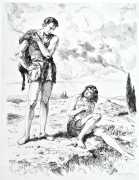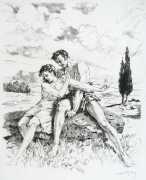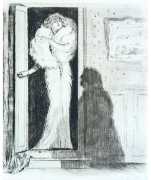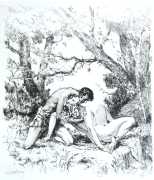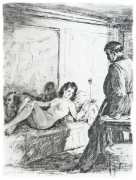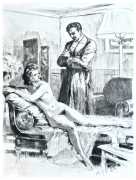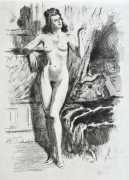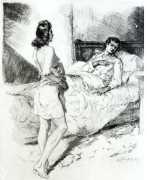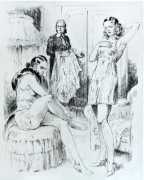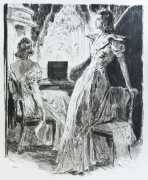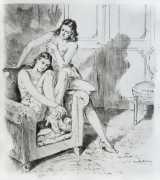 One of the less well-known books by French author Pierre Louÿs is his collection of stories entitled Sanguines, first published in 1903. In French, sanguine has the meaning of red chalk, or a drawing in that medium, suggesting that these stories are intended to be broad sketches of situations, rather than detailed studies.
One of the less well-known books by French author Pierre Louÿs is his collection of stories entitled Sanguines, first published in 1903. In French, sanguine has the meaning of red chalk, or a drawing in that medium, suggesting that these stories are intended to be broad sketches of situations, rather than detailed studies.
Sanguines includes two stories set in classical Greece which are successors to Louÿs’s well-known works Bilitis and Aphrodite. The first is The Wearer of Purple (L’homme de poupre), the story of the artist Parrhasius, who tortures a model to death for the sake of authenticity. The second is Dialogue au soleil couchant (Dialogue at Sunset), a romantic exchange between the young shepherd Arcas and a girl called Melitta. The book also contains a variety of tales set in the modern day, though A New Sensation (Une volupté nouvelle) bridges ancient and modern settings by bringing the nymph Callisto from ancient times into contemporary France, where she turns up suddenly at the door of a man’s apartment, only to discover that little has changed over a few thousand years. The Ascent of the Venusberg might be put in the same category, involving contact with the goddess Aphrodite/Venus in Germany of the early twentieth century.
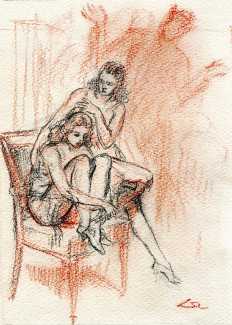
The stories in Sanguines which have a contemporary setting are predominantly concerned with sexual violence, or the threat of it. These include A Landing from the Roadstead at Nemours (Escale en rade de Nemours), set in Morocco, where a jealous husband murders his wife and her lover when he discovers them in bed together, The Venetian Blind (La persienne), in which a girl witnesses an attempted rape at knife point outside her bedroom window; the victim stabs her attacker, and The Strange Adventure of Madame Esquollier (L’aventure extraordinaire de Madame Esquollier), where a mother and her daughter are abducted as they leave the opera and are taken to a remote house; they are stripped to their underclothes and anticipate rape and murder, but in fact the whole purpose is for a couturier to measure their dresses so that he can copy their fine tailoring.
There is a thread of surrealism or fantasy in several of the stories in the collection. Une volupté nouvelle, as we have seen, involves the time-travel of Callisto to Paris in the 1900s. In The Impersonation of Esther (La fausse Esther), the philosopher Esther Gobseck discovers that her name has been used by Honoré Balzac as the name of the prostitute heroine of his book, the Highs and Lows of a Harlot (Splendeurs et misères des courtisanes, 1847). She travels to Paris to confront him, but he accuses her of imitating his character and concludes that she must be his fictional Esther brought to life. Accepting this, the real Esther then attempts to adopt the personality and lifestyle of her imaginary namesake. In In-Plano, a little girl creeps into her father’s library whilst her parents are out, opens one of his books and is terrified when one of the illustrations comes to life. Lastly, in Spring Night (Nuit de printemps), a woman in ancient Egypt is awaiting the arrival of her secret lover; instead, a century-old mummy enters her room and tries to molest her. She ‘murders’ the desiccated body with her long hair pins. These horrific and fantastical tales have a lot in common with the stories of Edgar Alan Poe, with which Louys was doubtless familiar.
By the time Lobel-Riche was commissioned to provide a portfolio of plates, Sanguines had already been illustrated several times, including by Antoine Calbet, Jean-Gabriel Daragnès and Mariette Lydis, but Lobel-Riche’s was the first comprehensive set of illustrations, and the most risqué.
The Lobel-Riche illustrated edition of Sanguines was published in Paris by Dominique Wapler, in a limited numbered edition of 325 copies.
The most accessible English translation of Sanguines is the one by James Cleugh, included in the American edition of the Collected Works of Pierre Louÿs, published in 1926 by the Pierre Louÿs Society. This volume also includes translations of Aphrodite, Bilitis, King Pausole, Woman and Puppet, Twilight of the Nymphs, and Psyche, and is illustrated with very second-rate woodcuts by Harry G. Spanner.
Much of this information is paraphrased from a comprehensive and fascinating blog piece about Sanguines by the British blogger John Kruse, whose complete article can be found here.


